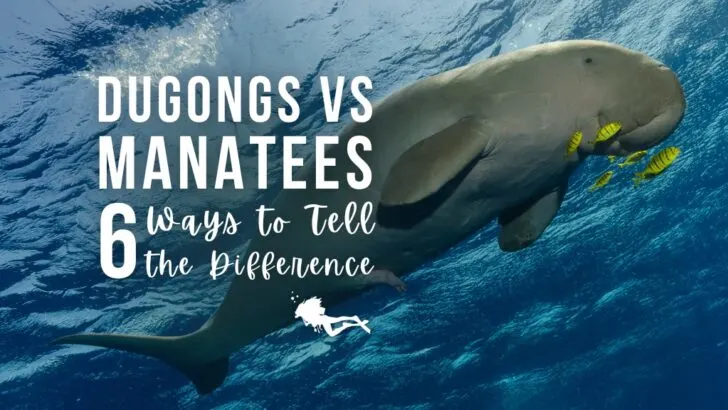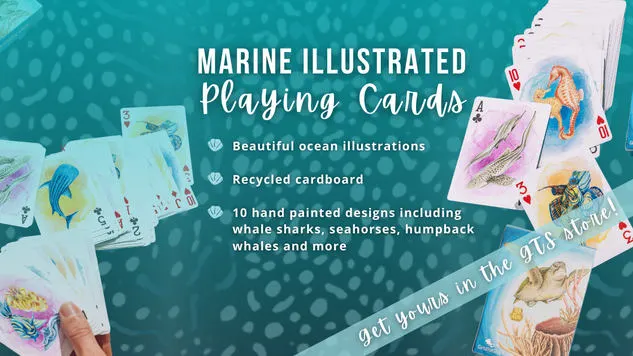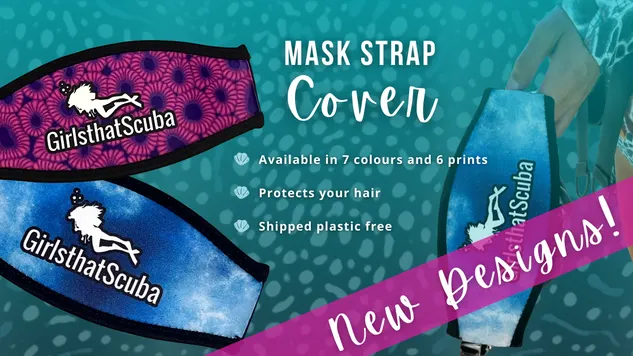Don’t know your dugong from your manatees? You’re in the right place! Next time you’re asking if it’s a dugong vs manatee, you’ll know the answer.
Both members of the taxonomic order Sirenia, dugongs and manatees are often mistaken for one another. In fact, historically, sailors even mistook them for mermaids. This was mainly thanks to their smooth bodies and tendency to glide at the surface of the sea.
Despite some similarities, dugongs and manatees are different animals. Luckily, there are some key physical and behavioural characteristics you can use to tell them apart from one another. Here, we’ll run through six ways to spot the difference between manatee and dugong.
Dugong vs Manatee Tails
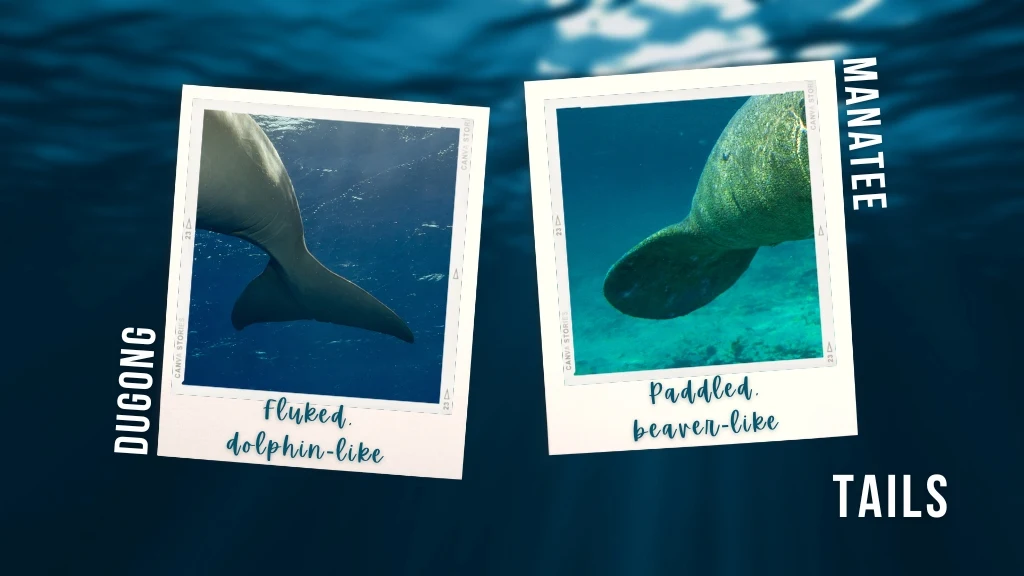
One of the easiest ways to tell the difference between a manatee and dugong is by looking at their tails.
Dugong tails are similar to dolphin, or even mermaid, tails. Two tail lobes are joined at the centre and stick out on either side. This is known as a fluked tail.
In contrast, manatee tails lack a fork. Instead, they’re paddle-like and are often compared to beaver tails. Both dugong and manatees use the upward and downward movement of their tails to propel themselves through the water.
Dugong: Fluked, dolphin-like, tails
Manatee: Paddled, beaver-like, tails
Snouts
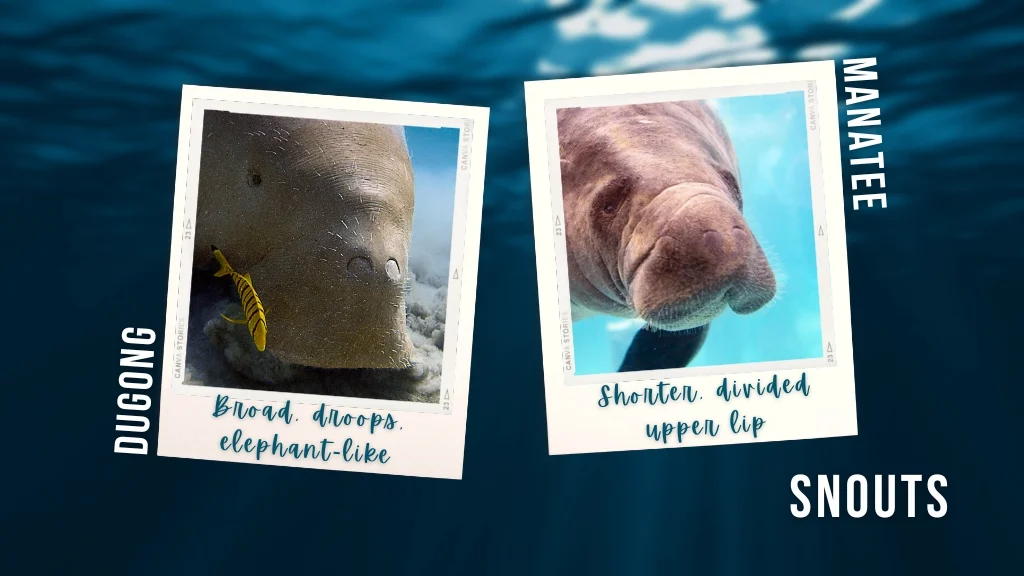
If you’re ever lucky enough to come face-to-face with a dugong or manatee in the water, make sure you get a good look at its snout.
A wide snout which droops down towards the seabed (like an elephant’s trunk) means you’re looking at a dugong. If it’s short and bulbous, with a divided upper lip, you’re looking at a manatee.
The shape of manatee lips enables them to grasp objects and manoeuvre them. This is known as a ‘prehensile’ lip.
Although rare in the marine world, prehensile lips are common on land. Rhinos, giraffes, tapirs, horses, and even bears all use their prehensile lips to feed on trees and shrubs.
Dugong: Broad, hangs down like an elephant trunk
Manatee: Shorter, rounded, divided upper lip
Teeth
Another key difference between manatee and dugong is their teeth.
They can be tricky to spot, but many dugongs have a pair of ‘tusks’ at the front of their mouths. The tusks are also referred to as overgrown upper incisors. Alongside their long trunks, the tusks add to the ‘elephant-like’ appearance of dugongs.
The tusks are typically found in post-pubescent males (males that have passed puberty). However, they can be found in mature (40+ years) females too. Once grown, these tusks will stay present throughout the dugong’s life. They can even be used to estimate the age of the dugong.
In contrast, manatee teeth are constantly replaced throughout the manatee’s life. This process is often referred to as ‘horizontal teeth replacement’ or ‘marching molars’.
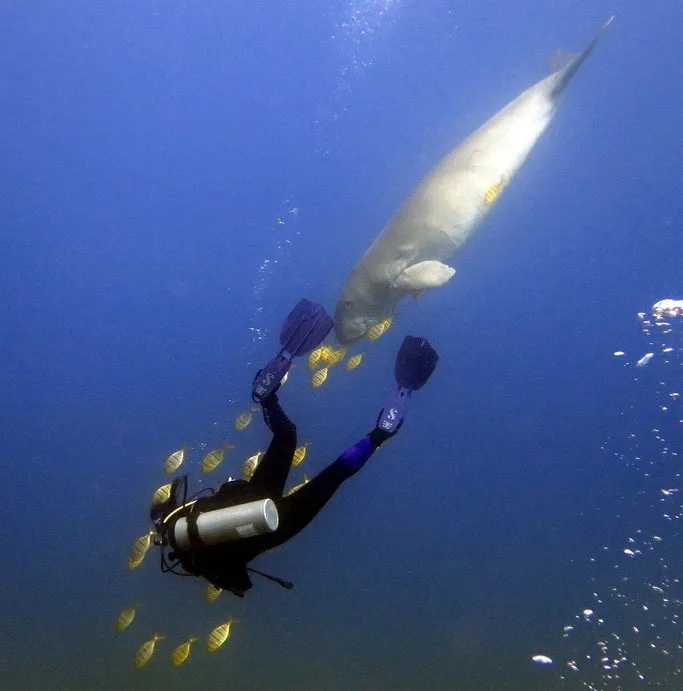
But why marching? Because the teeth don’t just fall out – they move too. New molars are formed towards the back of the jaw and move slowly to the front of the mouth. Then, they fall out of the mouth and are replaced by the teeth behind them. These then slowly move into the position of the old teeth.
In this way, it’s thought that manatees may go through several sets, and roughly 120 teeth, throughout their lives. A similar process occurs in some land-based mammals, including elephants and kangaroos.
Dugong: Overgrown upper incisors (in mature males and some females), teeth remain for a lifetime
Manatee: Teeth move from the back to the front of the mouth and are eventually replaced
Nails
Both manatees and dugongs use their flippers to steer themselves in certain directions. But, if you spot nails on the end of a flipper, you’re looking at a manatee.
Manatees are distant relatives of elephants, hyrax and aardvarks, all of which have nails. It’s thought that manatees once roamed the land alongside their relatives. On land, their nails would have helped them to manipulate objects as well as protect their extremities. Nowadays, their nails fulfil a similar role underwater.
However, this isn’t a fool proof method of distinguishing between a dugong vs manatee. Like dugongs, the flippers of Amazonian manatees lack nails. This means that a nail-less flipper doesn’t necessarily mean you’re looking at a dugong… But a nailed flipper means you’re definitely looking at a manatee!
Dugong: Flippers lack nails
Manatee: Flippers can have three to four nails (West Indian and African) or lack nails (Amazonian)
Dugong vs Manatee Habitats
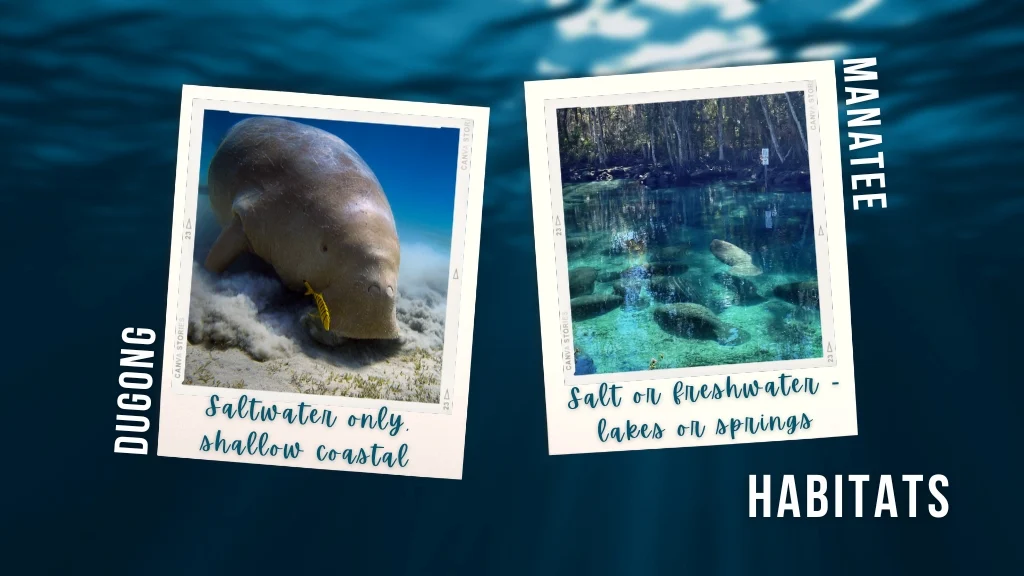
Behavioural patterns can also help you tell the difference between a manatee vs dugong, including where they live.
Dugong are found exclusively in shallow coastal waters. You’ll typically find them sheltering from strong currents in bays, mangrove forests and harbours. They’re found across the Indo-Pacific region, which spans East Africa to Australia. You can also find dugongs and dive with them in Marsa Alam, Egypt!
In contrast, manatees are found in both saltwater and freshwater. When the sea temperature drops, some populations will seek out warmer freshwater environments. This is known as partial migration, and it’s the reason why you can spot manatees in places like estuaries, lakes and springs.
Manatees also have a larger geographical range than dugongs. As well as the Indian Ocean, you can find them in the waters of the Amazon Basin and the Caribbean.
Dugong: Saltwater only, Indo-Pacific region
Manatee: Found in both saltwater and freshwater
Diet and Feeding
Dugongs and manatees are both predominantly herbivores. Despite this, their diets and feeding habits differ slightly.
Dugongs are what is known as bottom-feeders. As the name suggests, dugongs eat from the the sea floor. Their long trunks rip up plants, roots and all, which they ingest through their mouths.
Seagrass is by far their main source of food. This is why they stick to shallow coastal areas, where seagrass thrives. However, they will occasionally scoop up the odd invertebrate too.
Manatees also like seagrass and can feed from the bottom. They can even use their flippers to ‘walk’ across the floor and push food into their mouths.
However, unlike dugongs, manatees aren’t limited to a bottom-only menu. They also eat plants from other levels of the water column, including algae and some freshwater plant species.
Dugong: Predominantly seagrass, bottom feeders, feed via trunks
Manatee: Various saltwater and freshwater plants, use flippers to manoeuvre food, not limited to bottom food
Conservation of Dugongs and Manatees
Both dugongs and manatees belong to the taxonomic order of Sirenia. But did you know that this order used to have another member?
Steller’s sea cows were part of the Dugongidae family, alongside modern-day dugongs. They were much larger than their relatives, reaching astounding sizes of up to 9m (30 feet).
Sadly, this species suffered heavily at the hands of human hunters and is now extinct. The hunting of dugongs and manatees is restricted and illegal in many locations. However, in reality, these animals are still hunted for their meat and oil.
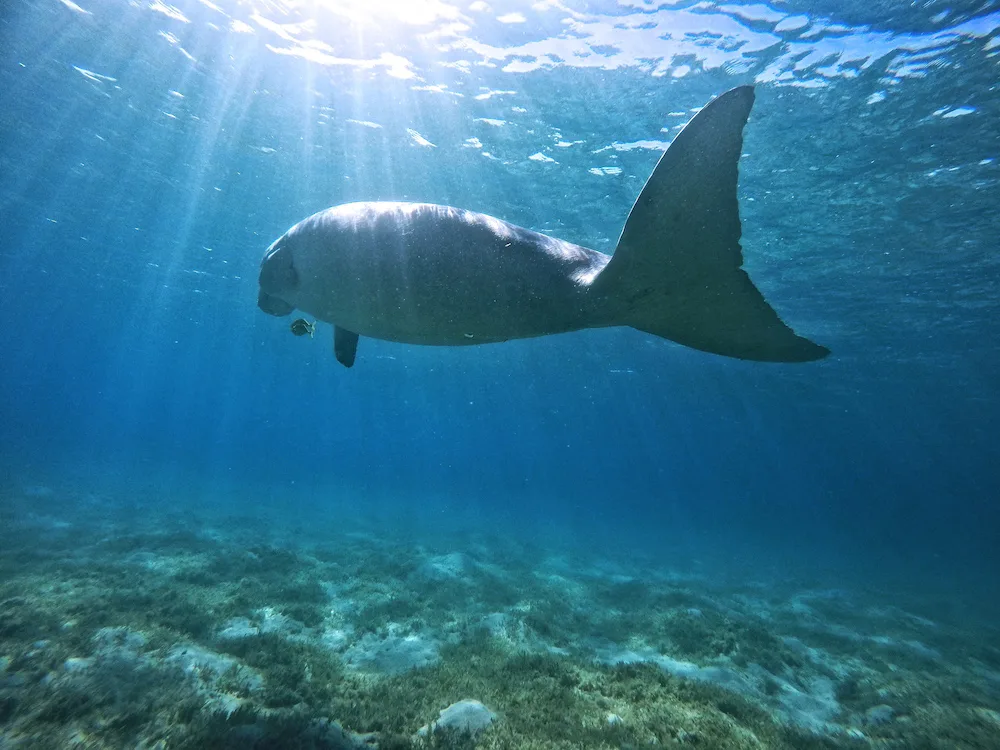
What’s more, dugong and manatee populations are under threat from various other human-related impacts. These include:
- Reduced food supply. Coastal development and climate change have led to huge reductions in global seagrass populations. You can read more about seagrass meadows and why they’re important here!
- Habitat destruction. Coastal developments and irresponsible anchoring in coastal areas have drastically reduced the number of safe dwelling places for manatees and dugongs.
- Ocean debris. Discarded fishing lines and hooks can injure and ensnare a range of sea life, included manatees and dugongs.
Combined, these impacts have caused manatee and dugong populations to plummet. In fact, dugongs, Amazonian manatees, American manatees, and African manatees are all listed as vulnerable to extinction by the International Union for Conservation of Nature (IUCN).
How can you help?
But it’s not all doom and gloom – there are plenty of charities out there working hard to protect existing dugong and manatee populations. Don’t forget, you can do your bit to help too – whether you live on the coast or not:
- East less fish. Less demand for fish means less fishing, which means less discarded fishing gear.
- Consider eco-friendly holidays. There are plenty of animal-friendly resorts out there. Green flags to look out for are careful anchoring policies, limited single-use plastics, and links with established conservation charities.
- Anchor responsibly. If you drive a boat in coastal areas, try to drop your anchor on sandy patches rather than seagrass. Keep an eye out for animals while you’re driving.
- Get involved. There are plenty of charities out there looking for volunteers and donations!

About the Author
Rose has spent the last few years living in Europe, the Seychelles and Kenya, working as a dive instructor, writer and conservationist. She’s back in the UK at the moment and is slowly acclimatising to cooler waters!

